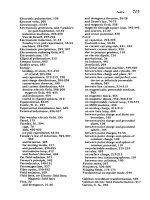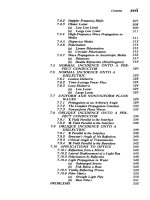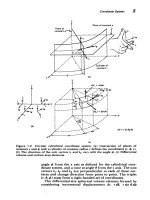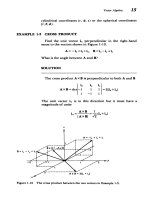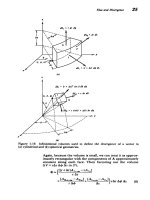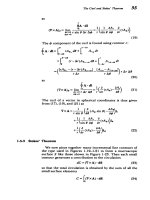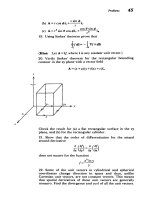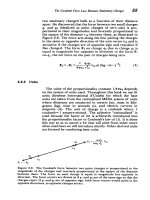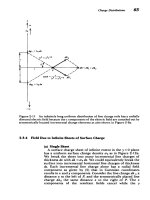Electromagnetic Field Theory: A Problem Solving Approach Part 5 ppsx
Bạn đang xem bản rút gọn của tài liệu. Xem và tải ngay bản đầy đủ của tài liệu tại đây (259.89 KB, 10 trang )
Vector
Algebra
15
cylindrical
coordinates
(r,
0, z)
or
the
spherical
coordinates
(r,
0,
0).
EXAMPLE
1-3
CROSS
PRODUCT
Find
the
unit
vector
i,,
perpendicular
in
the
right-hand
sense
to
the
vectors shown
in
Figure
1-10.
A=
-i.+i,+i,,
B=i i,+iý
What
is
the
angle
between
A
and
B?
SOLUTION
The
cross
product
Ax
B is
perpendicular
to
both
A
and
B
i,
i,
i,
AxB=det-1
1
1
=2(i,+i,)
1 -1 1
The
unit
vector
in
is
in
this
direction
but
it
must
have
a
magnitude
of
unity
AxB
1
i
A-
=
(ix
+i,)
B=
i,
Figure
.1-10
The
cross
product
between
the
two
vectors
in
Example
1-3.
16
Review
of
Vector
Analysis
The
angle
between
A
and
B is
found
using
(12)
as
sin
=AxBI
21
sin
0
AB
%/
=-22
0
=
70.5*
or
109.50
The
ambiguity
in
solutions
can
be
resolved
by
using
the
dot
product
of
(11)
A'B
-1
cos
0
-
-B~0
=
109.5
°
AB
3•
1-3
THE
GRADIENT
AND
THE
DEL
OPERATOR
1-3-1
The
Gradient
Often
we
are
concerned
with
the
properties
of
a
scalar
field
f(x,
y,
z)
around
a
particular
point.
The
chain
rule
of
differ-
entiation
then
gives
us
the
incremental
change
df
in
f
for
a
small
change
in
position
from
(x,
y, z)
to
(x
+
dx,
y
+
dy,
z
+dz):
af af
af
df
=
-dx
+
dy
+
dz
(1)
ax
Oy
Oz
If
the
general
differential distance
vector
dl
is
defined
as
dl=dx
i.+dy
i,+dz
i,
(2)
(1)
can
be
written
as
the
dot
product:
df
=
a-f
i,
+
i,
+ -
i)dl
ax
ay
az
=
grad
f
-
dl
(3)
where
the
spatial
derivative
terms
in
brackets
are defined
as
the
gradient
of
f:
grad
f
=
Vf=V
i
+
fi,+
fi
(4)
Ox
ay
az
The
symbol
V
with
the
gradient
term
is
introduced
as
a
general
vector
operator,
termed
the
del
operator:
V = ix
-+i,-7
+is (5)
ax
ay
Oz
By
itself
the
del
operator
is
meaningless,
but
when
it
premul-
tiplies
a
scalar
function,
the
gradient
operation
is
defined.
We
will
soon
see
that
the
dot
and
cross
products
between
the
del
operator
and
a
vector
also
define
useful
operations.
The
Gradient
and
the
Del
Operator
With
these definitions, the change
in
f
of
(3)
can be
written
as
df
=
Vf
-
dl
=
I
Vf
dl
cos
0
(6)
where
0
is
the
angle
between
Vf
and
the
position vector
dl.
The
direction
that
maximizes
the
change
in
the
function
f is
when
dl
is
colinear
with
Vf(O
=
0).
The
gradient
thus
has
the
direction
of
maximum
change
in f.
Motions
in
the
direction
along
lines
of
constant
f
have
0
=
ir/2
and
thus
by
definition
df
=
0.
1-3-2
Curvilinear Coordinates
(a)
Cylindrical
The
gradient
of
a
scalar
function
is
defined
for
any
coor-
dinate
system
as
that
vector
function
that
when
dotted
with
dl
gives
df.
In
cylindrical
coordinates
the
differential
change
in
f(r,
,
z) is
af
af
af
df=
dr+ý
d+-dz
(7)
or
0o
az
The
differential
distance
vector
is
dl=
dri,+
r
do
i6
+dz
i.
(8)
so
that
the
gradient
in
cylindrical
coordinates
is
af
laf
af
df
=
Vf
dl=>Vf=-
+i+
i
+
(9)
Or
r
4d
az
(b)
Spherical
Similarly
in
spherical
coordinates
the
distance
vector
is
dl=dr
i,+rdO
i,+r
sin
Odo
i
6
(10)
with
the
differential
change
of
f(r,
0,
46)
as
af
af
af
df
=
-dr+-dO+-
d4 =
Vf
-
dl
(11)
Or
0o
d4
Using
(10)
in
(11)
gives
the
gradient
in
spherical
coordinates
as
Af
Iaf 1
af
Af
IIi
+ I
a'
+ I i
Vf=-T+
+
i4
Ua
I
U
-
iII£
r r 80 r s n 0 ad
18
Review
of
Vector
Analysis
EXAMPLE
1-4
GRADIENT
Find
the
gradient
of
each
of
the
following
functions where
a
and
b
are
constants:
(a)
f =
ax
2
y
+byst
SOLUTION
-
af.
af*4f
Vf
=
-a
i,+-
i,
+ -
i.
8
x
ay
8z
=
2axyi.
+
(ax
+
3byz)i,
+
bysi,
(b)
f=
ar2
sin
q
+brz
cos
24
SOLUTION
S+af
.
af
Vf
=
-a
ir+
If i
+•-f
i,
ar
r
a4
az
=
(2ar
sin
4
+
bz
cos
20)i,
+
(ar
cos
4
-
2bz
sin
20)i,
+
br
cos
20i,
(c)
f
=a
+br
sin
0
cos
4
r
SOLUTION
af.
1
af
1 af
ar
r
rO
r
sin
0
a8
=
-
-+bsin
0
cos
4)i,+bcos
0
cos
-
sini
1-3-3
The
Line
Integral
In
Section
1-2-4 we
motivated
the
use
of
the
dot
product
through
the
definition
of
incremental
work
as
depending
only
on
the
component
pf
force
F
in
the
direction
of
an
object's
differential
displacement
dl.
If
the
object
moves
along
a
path,
the
total work
is
obtained
by
adding
up
the
incremen-
tal
works
along
each
small
displacement
on
the
path
as
in
Figure
1-11.
If
we
break the
path
into
N
small
displacements
I~
The
Gradient
and
the
Del Operator
dl
6
Li
wl
ai,
N
N
W
dW,
F
-
di,
n 1
n=
1
lim
din
0
W
=
F
dl
N
-
fJ
L
Figure
1-11
The
total work
in
moving
a
body over
a
path
is
approximately
equal
to
the sum
of
incremental
works
in
moving
the
body
each
small
incremental
distance
dl.
As
the differential
distances
approach
zero
length,
the
summation
becomes
a
line
integral
and
the
result
is
exact.
dl,
d1
2
,
. ,
dN,
the
work
performed
is
approximately
W
-F
*
dl
1
+F
2
'
dl
2
+
F
3
di+
•
•
+FN
dlN
N
Y
F,
*
dl,
(13)
n=l
The
result
becomes
exact
in
the
limit
as
N
becomes
large
with
each
displacement
dl,
becoming
infinitesimally
small:
N
W=
lim
Y
Fn.dl,=
F
dl
(14)
N-o
n=1
dl,, O
In
particular,
let
us
integrate
(3)
over
a
path
between
the
two
points
a
and
b
in
Figure
1-12a:
Sdf
=
fi,-fl.=
Vf
dl
(15)
Because df
is
an
exact
differential,
its
line
integral
depends
only
on
the
end
points
and
not
on
the
shape
of
the contour
itself.
Thus,
all
of
the
paths
between
a
and
b
in
Figure
1-12a
have
the
same
line
integral
of
Vf,
no
matter
what
the
function
f
may
be.
If
the
contour
is
a
closed
path
so
that
a
=
b,
as
in
20
Review
of
Vector
Analysis
2
b
4
2
31.
V
f"
di
=
f(b)
-
f(a)
a
1
Y
(a)
Figure
1-12
The
component
of
the
gradient
of
a
function
integrated
along
a
line
contour
depends
only
on
the
end
points
and
not
on
the
contour
itself.
(a) Each
of
the
contours
have
the
same
starting
and
ending
points
at a
and
b
so
that
they
all
have
the
same
line
integral
of
Vf.
(b)
When
all
the
contours
are
closed with
the
same
beginning
and ending
point
at
a,
the
line
integral
of
Vf
is
zero.
(c)
The
line
integral
of
the
gradient
of
the function
in
Example
(1-5)
from
the
origin
to
the
point
P
is
the
same
for
all
paths.
Figure
1-12b,
then
(15)
is
zero:
Lvf
dl=L f.=0
(16)
where
we
indicate
that the
path
is
closed
by
the
small circle
in
the
integral
sign
f.
The
line
integral
of
the
gradient
of
a
function
around
a
closed
path
is
zero.
EXAMPLE
1-5
LINE
INTEGRAL
For
f=x
2
y,
verify
(15)
for
the
paths
shown
in
Figure
1-12c
between
the
origin
and
the
point
P
at
(xo,
yo).
SOLUTION
The
total
change
in
f
between
0
and
P
is
df
f
-flo
=
xoYo
From the
line
integral
along
path
1
we
find
Yo
0o
xo
2
Vf
-dl=
f
dy+f=
xoyo
Y_0
Ir
X=0
ax
0
IJ
I
Flux
and
Divergence
21
Similarly,
along
path
2
we
also
obtain
Vf
dl=
o
&o,
+
o
dy_
xoyo
while
along
path
3
we
must
relate
x
and
y
along the straight
line as
Yo
Yo
y
=
x
dy
=
dx
xo
xo
to yield
vf
*
dl=
I(-ý
dx
+.
dy)
=
o
dx
=
xOyo
Jo
\ax
ay
x
J.=o
Xo
1-4
FLUX
AND
DIVERGENCE
If
we
measure
the
total
mass
of
fluid
entering
the
volume
in
Figure
1-13
and
find
it
to
be
less
than
the
mass
leaving,
we
know
that
there
must
be
an
additional
source
of
fluid
within
the pipe.
If
the
mass
leaving
is
less
than
that
entering,
then
Flux
in
=
Flux
out
Flux
in
<
Flux
out
" /
-,
•
Source
Flux
in
>
Flux
out
Sink
Figure
1-13
The
net
flux
through
a
closed
surface
tells
us
whether
there
is
a
source
or
sink
within
an
enclosed
volume.
22
Review
of
Vector
Analysis
there
is
a
sink
(or
drain)
within
the
volume.
In
the
absence
of
sources
or
sinks,
the
mass
of
fluid leaving
equals
that
entering
so
the
flow
lines
are
continuous.
Flow
lines
originate at
a
source
and
terminate
at
a
sink.
1-4.1 Flux
We
are
illustrating
with
a fluid analogy
what
is
called
the
flux
4
of
a
vector
A
through
a
closed
surface:
D
=
f
AdS
(1)
The
differential
surface
element
dS
is
a
vector
that
has
magnitude
equal
to
an
incremental area
on
the
surface
but
points
in
the
direction
of
the
outgoing
unit
normal
n
to
the
surface
S,
as
in
Figure
1-14.
Only
the
component
of
A
perpendicular
to
the
surface
contributes
to
the
flux,
as
the
tangential
component
only
results
in
flow
of
the
vector
A
along
the
surface
and
not
through
it.
A
positive
contribution
to
the
flux
occurs
if
A
has
a
component
in
the
direction
of
dS
out
from
the
surface.
If the
normal
component
of
A
points
into
the
volume,
we
have
a
negative
contribution
to
the
flux.
If
there
is
no
source
for
A
within
the
volume
V
enclosed
by
the surface
S,
all
the
flux
entering
the
volume equals
that
leaving
and
the
net
flux
is
zero.
A
source
of
A
within
the
volume
generates
more
flux
leaving
than
entering
so
that
the
flux
is
positive
(D
>
0)
while
a
sink
has
more
flux
entering
than
leaving
so
that
D
<
0.
dS
n
dS
Figure
1-14
The
flux
of
a
vector
A
through
the
closed
surface
S
is
given
by
the
surface
integral
of
the
component
of
A
perpendicular
to
the
surface
S.
The
differential
vector
surface
area
element
dS
is
in
the
direction
of
the
unit
normal
n.
i
Flux
and
Divergence
23
Thus
we
see
that the
sign
and
magnitude
of
the
net
flux
relates
the
quantity
of
a
field
through
a
surface
to
the
sources
or
sinks
of
the
vector
field
within
the
enclosed
volume.
1-4-2
Divergence
We
can be
more
explicit
about
the
relationship
between
the
rate
of
change
of
a
vector
field
and
its
sources
by
applying
(1)
to
a
volume
of
differential
size,
which
for
simplicity
we
take
to
be
rectangular
in
Figure
1-15.
There
are
three
pairs
of
plane
parallel
surfaces
perpendicular
to
the
coordinate
axes
so
that
(1) gives
the
flux
as
()=
f
A.(x)
dy
dz
-
A.
(x
-Ax)
dy
dz
+
JA,(y
+
Ay)
dx
dz
-
A,
(y)
dx
dz
+j
A(z
+Az)
dxdy-
A,(z)dxdy
(2)
where
the
primed
surfaces
are
differential
distances
behind
the
corresponding
unprimed
surfaces.
The
minus
signs
arise
because
the
outgoing
normals
on
the
primed
surfaces
point
in
the
negative
coordinate
directions.
Because
the
surfaces
are
of
differential
size,
the
components
of
A
are
approximately
constant
along
each
surface
so
that
the surface
integrals
in
(2)
become
pure
dS,
=
Ax
Ay
Figure
1-15
Infinitesimal
rectangular
volume
used
to
define
the
divergence
of
a
vector.
Ay
Aze
24
Review
of
Vector
Analysis
multiplications
of
the
component
of
A
perpendicular
to
the
surface
and
the
surface
area.
The
flux
then
reduces
to
the
form
(
[Ax(x)-Ax(x
-Ax)]
+
[A,(y
+Ay)-A,(y)]
Ax
Ay
+
Ax
Ay
Az
(3)
We
have
written
(3)
in
this
form
so
that
in
the
limit
as
the
volume
becomes
infinitesimally
small,
each
of
the
bracketed
terms
defines
a
partial
derivative
aA
3A
ýAMz
lim
=
( + +
A
V
(4)
ax-o
\ax
ay
az
where
AV
=
Ax
Ay
Az
is
the
volume
enclosed
by
the surface
S.
The
coefficient
of
AV
in
(4)
is
a
scalar
and
is
called
the
divergence
of
A.
It
can
be
recognized
as
the
dot
product
between
the
vector del
operator
of
Section
1-3-1
and
the
vector
A:
aAx
aA,
aA,
div
A
=
V
-
A
=
-+ +
(5)
ax
ay
az
1-4-3
Curvilinear
Coordinates
In
cylindrical
and
spherical
coordinates, the divergence
operation
is
not
simply
the
dot
product
between
a
vector
and
the
del
operator
because
the
directions
of
the
unit
vectors
are
a
function
of
the coordinates.
Thus,
derivatives
of
the
unit
vectors
have
nonzero
contributions.
It
is
easiest to
use
the
generalized
definition
of
the divergence
independent
of
the
coordinate
system,
obtained
from
(1)-(5)
as
V
A=
lim
ý'A.dS
(6)
v-,o
AV
(a)
Cylindrical
Coordinates
In
cylindrical
coordinates
we
use
the
small
volume
shown
in
Figure
1-16a
to
evaluate
the net
flux
as
D
=
sA
dS
=f
(r+Ar)Ar,,,
,
dk
dz
-
rArr,,
ddz
+
I
A4,.
dr
dz
-
A6,
dr
dz
r
+ i
rA,,•+.
dr
db
- I
rA,,=
dr
db
.J
3
J1
3
